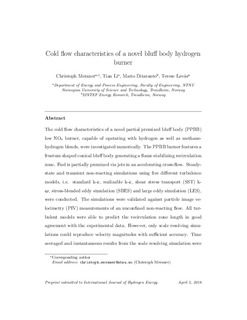| dc.contributor.author | Meraner, Christoph | |
| dc.contributor.author | Li, Tian | |
| dc.contributor.author | Ditaranto, Mario | |
| dc.contributor.author | Løvås, Terese | |
| dc.date.accessioned | 2018-05-08T07:48:44Z | |
| dc.date.available | 2018-05-08T07:48:44Z | |
| dc.date.created | 2018-03-15T08:19:45Z | |
| dc.date.issued | 2018 | |
| dc.identifier.citation | International journal of hydrogen energy. 2018, 43 (14), 7155-7168. | nb_NO |
| dc.identifier.issn | 0360-3199 | |
| dc.identifier.uri | http://hdl.handle.net/11250/2497468 | |
| dc.description.abstract | The cold flow characteristics of a novel partial premixed bluff body (PPBB) low NOx burner, capable of operating with hydrogen as well as methane-hydrogen blends, were investigated numerically. The PPBB burner features a frustum shaped conical bluff body generating a flame stabilizing recirculation zone. Fuel is partially premixed via jets in an accelerating cross-flow. Steady-state and transient non-reacting simulations using five different turbulence models, i.e. standard k-ε, realizable k-ε, shear stress transport (SST) k-ω, stress-blended eddy simulation (SBES) and large eddy simulation (LES), were conducted. The simulations were validated against particle image velocimetry (PIV) measurements of an unconfined non-reacting flow. All turbulent models were able to predict the recirculation zone length in good agreement with the experimental data. However, only scale resolving simulations could reproduce velocity magnitudes with sufficient accuracy. Time averaged and instantaneous results from the scale resolving simulation were analysed in order to investigate flow characteristics that are special about the PPBB burner design and of relevance for the combustion process. Two different burner configurations were studied and their effects on the flow field were examined. The recirculation zone volume as well as the entrainment into the wall jet around the bluff body were found to correlate with the elevation of the bluff body relative to the burner throat. Both of these parameters are expected to have a strong impact on the overall NOx emission, since the near burner region is typically one of the main contributors to the NOx formation. © 2018 Hydrogen Energy Publications LLC. | nb_NO |
| dc.language.iso | eng | nb_NO |
| dc.publisher | Elsevier | nb_NO |
| dc.rights | Attribution-NonCommercial-NoDerivatives 4.0 Internasjonal | * |
| dc.rights.uri | http://creativecommons.org/licenses/by-nc-nd/4.0/deed.no | * |
| dc.title | Cold flow characteristics of a novel bluff body hydrogen burner | nb_NO |
| dc.type | Journal article | nb_NO |
| dc.type | Peer reviewed | nb_NO |
| dc.description.version | acceptedVersion | nb_NO |
| dc.source.pagenumber | 7155-7168 | nb_NO |
| dc.source.volume | 43 | nb_NO |
| dc.source.journal | International journal of hydrogen energy | nb_NO |
| dc.source.issue | 14 | nb_NO |
| dc.identifier.doi | 10.1016/j.ijhydene.2018.02.062 | |
| dc.identifier.cristin | 1572925 | |
| dc.relation.project | Norges forskningsråd: 193816 | nb_NO |
| dc.description.localcode | © 2018 Hydrogen Energy Publications LLC. Published by Elsevier Ltd. All rights reserved.This is the authors' accepted and reviewed manuscript of the article, LOCKED until 8 March 2020 due to copyright restrictions. | nb_NO |
| cristin.unitcode | 194,64,25,0 | |
| cristin.unitname | Institutt for energi- og prosessteknikk | |
| cristin.ispublished | true | |
| cristin.fulltext | postprint | |
| cristin.qualitycode | 2 | |

